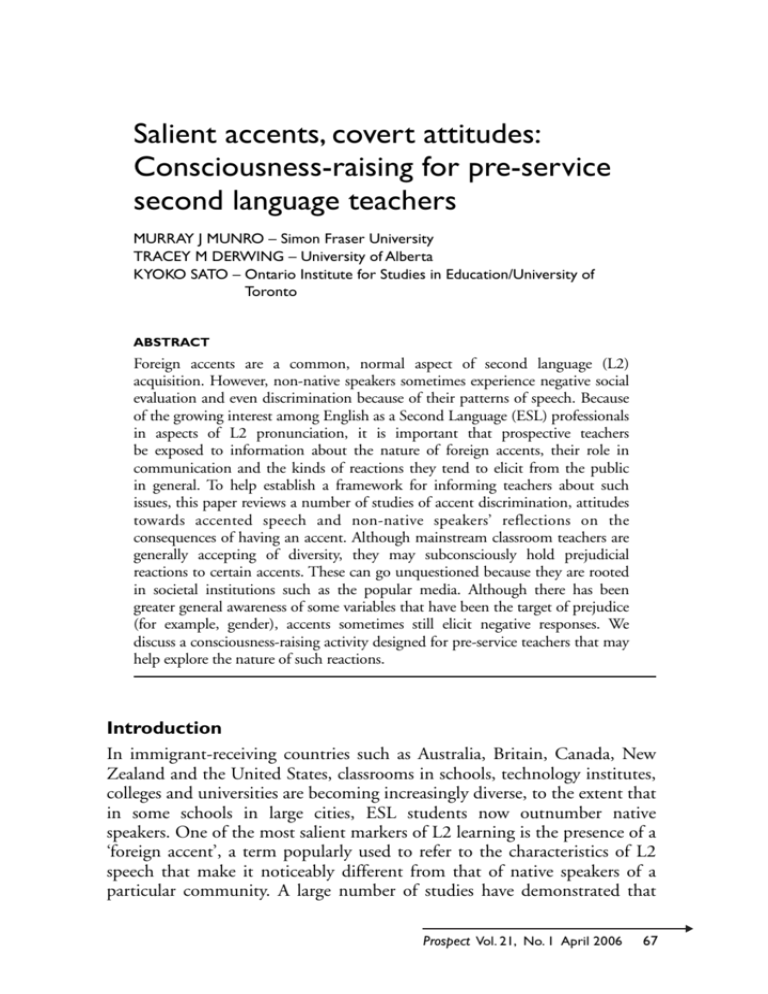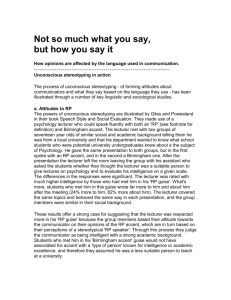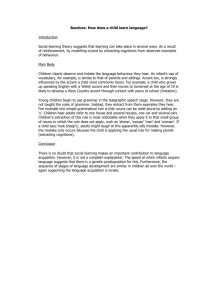Prospect 21 1 Final
advertisement

Salient accents, covert attitudes: Consciousness-raising for pre-service second language teachers MURRAY J MUNRO – Simon Fraser University TRACEY M DERWING – University of Alberta KYOKO SATO – Ontario Institute for Studies in Education/University of Toronto ABSTRACT Foreign accents are a common, normal aspect of second language (L2) acquisition. However, non-native speakers sometimes experience negative social evaluation and even discrimination because of their patterns of speech. Because of the growing interest among English as a Second Language (ESL) professionals in aspects of L2 pronunciation, it is important that prospective teachers be exposed to information about the nature of foreign accents, their role in communication and the kinds of reactions they tend to elicit from the public in general. To help establish a framework for informing teachers about such issues, this paper reviews a number of studies of accent discrimination, attitudes towards accented speech and non-native speakers’ reflections on the consequences of having an accent. Although mainstream classroom teachers are generally accepting of diversity, they may subconsciously hold prejudicial reactions to certain accents. These can go unquestioned because they are rooted in societal institutions such as the popular media. Although there has been greater general awareness of some variables that have been the target of prejudice (for example, gender), accents sometimes still elicit negative responses. We discuss a consciousness-raising activity designed for pre-service teachers that may help explore the nature of such reactions. Introduction In immigrant-receiving countries such as Australia, Britain, Canada, New Zealand and the United States, classrooms in schools, technology institutes, colleges and universities are becoming increasingly diverse, to the extent that in some schools in large cities, ESL students now outnumber native speakers. One of the most salient markers of L2 learning is the presence of a ‘foreign accent’, a term popularly used to refer to the characteristics of L2 speech that make it noticeably different from that of native speakers of a particular community. A large number of studies have demonstrated that Prospect Vol. 21, No. 1 April 2006 67 MURRAY J MUNRO,TRACEY M DERWING and KYOKO SATO a foreign accent is a common, normal aspect of the speech of those who acquire their L2 after early childhood (Tahta, Wood and Loewenthal 1981; Scovel 1988; Long 1990; Flege, Munro and MacKay 1995). Even linguistically unsophisticated listeners are highly sensitive to accent differences and readily perceive the speech of L2 learners as accented (Flege 1984; Scovel 1988). One of the potential consequences of speaking differently from other members of a community, whether one is an L2 learner or whether one simply speaks a different language variety, is negative social evaluation. In fact, minority accents are often disparaged or held to be signs of ignorance or lack of sophistication. Such views are reinforced by television and movies that regularly associate negative stereotypes with speakers exhibiting particular speech patterns (see Lippi-Green 1997). Even people who are generally accepting of diversity, including teachers, may subconsciously hold prejudicial reactions to certain types of accented speech, perhaps because they have not critically examined their own susceptibility to media influences. At times, negative reactions to accents may even be expressed in public, despite increasing awareness of many of the variables that have often been the target of prejudice and discrimination (for example, visible minority status1, gender, sexual orientation). It was recently reported in New Zealand, for instance, that a Chinese-speaking Member of Parliament was mocked because of her accent while asking questions in Parliament (Young 2005). As a result of the growing awareness of the important role of pronunciation in communication, more L2 researchers, teachers and teacher educators are focusing their attention on accent-related issues. The result has been a notable increase in the availability of pedagogical resources on pronunciation. Pronunciation interest groups, for instance, now play a role at major L2 conferences, and prominent journals, such as TESOL Quarterly, have devoted special issues to pronunciation matters. Furthermore, it seems clear that an understanding of pronunciation issues is becoming an indispensable part of training programs for English language teachers. Among the topics related to L2 speech that should be broached with prospective teachers is the nature of public attitudes towards those who speak with an accent. In this paper we seek to provide a framework for such a discussion, first by reviewing research on people’s responses to accented speech, and then by proposing a consciousness-raising activity to help future teachers understand the nature of accent-based stereotyping. Speaker intelligibility and accent discrimination Second language speakers sometimes have problems making themselves 68 Prospect Vol. 21, No. 1 April 2006 SALIENT ACCENTS, COVERT ATTITUDES: CONSCIOUSNESS-RAISING FOR PRE-SERVICE SECOND LANGUAGE TEACHERS understood because of pronunciation difficulties. For instance, mispronunciations of individual vowels and consonants can cause listeners to hear the wrong word, as when a speaker says sheep instead of ship, or lice instead of rice. Errors in stress and rhythm can also cause serious misunderstandings (Hahn 2004). For example, in Canadian English the difference between the two statements I can go and I can’t go is signalled primarily by the stress on the word can’t in the latter phrase and by the concomitant vowel quality, whereas can is not stressed. If a speaker fails to observe this distinction, the listener may completely misinterpret the intended meaning. Other aspects of non-native prosody can also result in miscommunication. In English, intonation patterns express not only particular functions (for example, list intonation) but pragmatic information as well. If first language intonation patterns are transferred directly into the second language, native listeners may misinterpret the speaker’s intent. Consider the following story (Derwing and Munro 2006) told by a Russian immigrant to Canada: And I had one funny problem, because Russian is very hard language, and when I spoke English, you know, it sounds very rude. Now I try to make softer. You know, I was working for one woman, Canadian. I helped her to clean her house couple times. And after she told me, ‘I don’t understand, you are rude, or just because of your bad English?’ I told her, ‘What I did wrong?’ She told me like your tone of your voice and some, like I construct my question, she told me it’s not proper way in Canada, and after only I start thinking try to get some information about this ... Like I asked her, ‘What do you want?’ and tone of my voice and she told me, ‘No, it’s not good in Canada to ask this way. You should ask, ‘What would you like?’ and change the tone of your voice. The Canadian woman in this situation provided helpful feedback to the Russian woman by pointing out how her productions were interpreted. These remarks illustrate how misunderstandings based on transferred intonation patterns can result in strong negative reactions on the part of listeners if they are unaware that that these patterns are not intended to convey the emotion that is inadvertently expressed. The film Crosstalk (Twitchin 1979), which calls for greater cross-cultural understanding, illustrates this type of confusion very well. Despite these problematic aspects of accented speech, it has been shown repeatedly that an accent in itself is not necessarily an obstacle to communicative success. In fact, speakers who exhibit strong non-native accents are often perfectly well understood (Derwing and Munro 1997; Munro and Derwing 1999). Nonetheless, extremely negative views of Prospect Vol. 21, No. 1 April 2006 69 MURRAY J MUNRO,TRACEY M DERWING and KYOKO SATO foreign accents have been promulgated by a number of sources, including the popular media (see Lippi-Green 1997) and even by language professionals. In the case of the latter, the views have ranged from those of the speech pathologists Greene and Wells (1927), who classified accent in the same category as imbecility, ataxia, cerebral palsy, multiple sclerosis and cleft palate, to those of specialists in Teaching English as a Second Language (TESL) such as Griffen (1991: 182), who maintained that: ‘The goal of instruction in pronunciation is that the student ... should learn to speak the language as naturally as possible, free of any indication that the speaker is not a clinically normal native.’ One recent manifestation of negative views of accent is the rise of ‘accent-reduction’ programs that claim to reduce or eliminate an accent for its own sake, not because it creates an impediment to communication. According to some speech pathologists and those TESL instructors who advocate accent reduction, the onus is on the non-native speaker to achieve native-speaker pronunciation norms, virtually an impossible task for most adults (Long 1990). One consequence of this attitude is the common practice of hiring only native speakers as teachers of English as a Foreign Language or ESL, even where there are trained non-native teachers available who have extremely high proficiency in English and who may be more sensitive to the difficulties of L2 students (Medgyes 1994; Llurda 2005). That accent discrimination actually occurs in the school setting is confirmed by recent human rights cases, such as that of Gajecki versus the Surrey School District in British Columbia, Canada (Munro 2003). Gajecki, who had a Polish accent, had been working successfully as a substitute teacher in English-speaking schools for years, during which time there had been no indication of any communication difficulties on his part. However, following a routine evaluation, an administrator placed a negative comment in his file stating that Gajecki ‘did not speak English’. Subsequently, he was not sent to schools. A human rights tribunal found that the school board had denied him employment because of his accent and ordered the school trustees to pay compensation and damages. Some evidence for differential treatment of ESL students at the classroom level comes from Schinke-Llano (1983; 1986), who showed that teachers consistently underestimated the linguistic proficiency of their ESL students. As a result, the teachers tended to limit their interactions with ESL students to simple classroom management discourse, rather than to engage in discussions of the subject matter under consideration. This reticence to talk to ESL students is the result of a form of stereotyping in that the teachers prejudged the comprehension abilities of the students on the basis of their oral productions. This particular instance of discrimination 70 Prospect Vol. 21, No. 1 April 2006 SALIENT ACCENTS, COVERT ATTITUDES: CONSCIOUSNESS-RAISING FOR PRE-SERVICE SECOND LANGUAGE TEACHERS may be reflective of broader societal attitudes towards accented speech. Evaluative reactions towards accented speech Individuals with a foreign accent may be perceived negatively because of the stereotypes or prejudices that accent can evoke in a listener. Such negative perceptions can have an adverse influence on how speakers are treated in a speech community (see Matsuda 1991; Lippi-Green 1997). Many researchers have taken an interest in the ways in which people respond to accented speech. The rationale for speech evaluation studies is based on the assumption that ‘the stereotyped impressions that members of one ethnolinguistic group [hold] of another group could be called forth effectively by speech cues alone’ (Lambert 1967, cited in Brennan and Brennan 1981: 207–8). That is, when listeners are exposed to accented speech, pre-existing stereotypes associated with that particular accent may be invoked. One of the earliest studies exploring stereotypical attitudes towards accented speech was carried out by Lambert (1967) in a Canadian context. Although Canada is officially bilingual, English is the dominant language and there are negative attitudes toward French. The study used the ‘matched-guise’ technique in which bilingual speakers read the same passage twice, once in English and once in Canadian French. When the speech samples were presented to Canadian English and Canadian French listeners for evaluation, it was found that both groups of listeners rated Canadian English guises more favourably than Canadian French guises. According to several studies, the degree of accent exhibited by a speaker is related to status judgments, regardless of whether the accent is a native variety representing a different dialect (Giles 1972) or a non-native accent (Brennan and Brennan 1981). Kalin and Rayko (1978) reported that native speakers of English generally judged non-native speakers (Italian, Greek, Portuguese, West African, Yugoslavian) to be less suitable for high-status jobs and more suitable for low-status jobs than native speakers. Dávila, Bohara and Saenz (1993) found evidence that the strength of speakers’ non-native accents correlated negatively with income among Mexican Americans, and further evidence of negative reactions to accented speech has been documented in several other studies. For the purposes of this paper, it is particularly important to recognise that experience with accented speech influences people’s attitudes and their responses to it. Gass and Varonis (1984) showed, for instance, that familiarity with a particular accent, a particular speaker, accents in general or the subject matter produced by someone with an accent results in Prospect Vol. 21, No. 1 April 2006 71 MURRAY J MUNRO,TRACEY M DERWING and KYOKO SATO improved comprehension. In fact, familiarity was an important variable in Sato’s (1998) study of students’ attitudes towards accented speech. She found that rural high school students rated non-native speech samples more negatively than native speaker productions on scales representing personality (for example, kindness, sociability), solidarity (for example, reliability, cooperativeness), speech characteristics (for example, pleasantness, comprehensibility) and education level. Urban high school students also favoured native English speakers, but to a lesser degree. However, her finding that university students did not distinguish between native and nonnative speaker voices on the measured dimensions suggests that familiarity can influence people’s reactions to non-native speakers’ speech, and that level of education, maturity or awareness of ‘politically correct’ responses may also play a role in determining people’s reactions to non-native speech. As Sato’s research demonstrates, rating scale judgments may be useful in accessing people’s attitudes toward accented speech. However, one must be careful in interpreting data of this type. First, the nature of the task is to invite listeners to discriminate among L2 speakers by labelling some more negatively than others. The raters are, in effect, given permission to exhibit stereotyping behavior. There is a danger, then, that rating scale data may exaggerate the degree to which some raters actually stereotype speakers. While some listeners may simply follow instructions in an effort to satisfy the experimenter, our experience is that listeners who are relatively sophisticated with respect to diversity issues may be unwilling to even perform such a task. For instance, in research involving students involved in a social work program, Derwing, Rossiter and Munro (2002) found that a majority of participants refused to respond to questions of the type employed by Sato on the grounds that they could not generalise from a few instantiations of ‘Vietnamese speakers’ to all people from Vietnam. Moreover, raters who hold negative stereotypes about some language groups may sometimes be unwilling to express those attitudes, even in an anonymous study. Consequences of stereotyping Stereotyping on the basis of language occurs in a wide variety of contexts, ranging from individual classrooms to educational proposals that underlie the curriculums for entire countries. In the case of the latter, the concern is often with issues of international communication. It is legitimate to be concerned about the mutual intelligibility of English speakers around the world; in fact, many writers have commented on the complex issues related to this problem (Kachru 1976; Nelson 1982; Kachru 1982; Crystal 1997; 72 Prospect Vol. 21, No. 1 April 2006 SALIENT ACCENTS, COVERT ATTITUDES: CONSCIOUSNESS-RAISING FOR PRE-SERVICE SECOND LANGUAGE TEACHERS Jenkins 2000). Nevertheless, it is important to research the question of intelligibility in a systematic way, rather than to resort to stereotyping or to make unwarranted assumptions. Van der Walt (2000), for instance, cites scholars who have argued that British English should be adopted as the educational standard in South Africa on the grounds that local varieties of South African English would be unintelligible to an international audience. However, these claims were made in the absence of empirical evidence; indeed, Van der Walt’s (2000) study demonstrated that several varieties of South African English are comprehensible to people unfamiliar with these dialects. Most people are probably prone to relying on stereotypes in the absence of first-hand knowledge. Such stereotyping is not necessarily associated with malice, though its consequences can be harmful. Research shows, however, that it is possible to change people’s attitudes towards accented speech and, moreover, that their interactions with non-native speakers may improve as a result. While familiarity with accents alone may improve both attitudes toward (Sato 1998), and comprehension of (Gass and Varonis 1984), accented speech, it is important to ask whether subtle kinds of stereotyping can be reduced through an open examination of both linguistic features and the effects of accent discrimination. In a study by Derwing, Rossiter and Munro (2002), pre-intervention social work students showed no evidence of strongly prejudicial attitudes toward speakers with non-native accents. Nonetheless, they reported difficulty understanding foreign-accented speech and a tendency to give up when faced with an L2 speaker with an accent. These students benefited from an intervention in which they were instructed in the phonological features of Vietnamese-accented speech, and received eight short cross-cultural training lessons. The students reported improved success in interactions with non-native speakers in real-life encounters, enhanced confidence in their ability to understand accented speech, increased empathy for L2 speakers, and an awareness of phonological differences between their own dialect of English and the productions of non-native speakers in general. A consciousness-raising activity Given the nature of educational institutions today and the subtle types of stereotyping of accented speech that occur, it may be helpful for pre-service teachers to be exposed to consciousness-raising activities to help them determine whether they hold covert negative attitudes towards accented speech. In addition, such exercises may help them understand the processes through which stereotyped attitudes are instilled and reinforced. Here we Prospect Vol. 21, No. 1 April 2006 73 MURRAY J MUNRO,TRACEY M DERWING and KYOKO SATO outline an activity designed for such a purpose, which may be easily adapted for use across a wide range of teacher education settings. Implementation of the activity requires three steps: 1 collection and preparation of a suitable selection of accented speech samples; 2 in-class audio presentation of the speech samples to pre-service teachers, who evaluate them on pre-determined dimensions; and 3 tallying of the results of the evaluations, followed by in-class discussion of the task outcomes. In the sections that follow we outline our own implementation of the task in a post-secondary classroom and discuss the students’ reactions to it. It is important to note, however, that we are describing a classroom technique and not an empirical research study. Therefore, we offer our observations as narrative commentary rather than in the form of quantitative or qualitative data. The students who completed the activity were Canadian undergraduates planning to work as ESL teachers. The speech samples were a collection of short narratives produced by speakers of Canadian English and speakers of Alabaman English. These two dialect groups were particularly suitable, given that Canadians are often exposed to negative stereotypes of American Southerners through television and movies (see Lippi-Green 1997), but are unlikely to have had much personal contact with individuals from the southern United States. Because Southerners are often portrayed as racist ‘rednecks’, we suspected that hearing southern-accented speech would evoke stereotypical reactions from Canadian pre-service teachers. Such a finding would be all the more interesting, given that the individuals we trained had self-selected to work with the ESL population and presumably considered themselves to be relatively accepting of people from different backgrounds. The narrators had been asked to recount the events depicted in a humorous picture story about two would-be hunters who end up photographing deer instead of shooting them. The university students’ regular instructor presented the recorded narratives in random order and asked them to rate the speakers on nine-point Likert scales. One of these was an accent scale, on which they identified the speakers as ‘more Canadian-sounding’ or ‘more American-sounding’. Another dimension was a scale ranging from ‘pleasant to listen to’ at one end and ‘unpleasant to listen to’ at the other. The most pertinent ratings of the speakers were given on a tolerance scale anchored with ‘tolerant’ at one end and ‘racist’ at the other. Our careful evaluation of the narratives that the speakers had 74 Prospect Vol. 21, No. 1 April 2006 SALIENT ACCENTS, COVERT ATTITUDES: CONSCIOUSNESS-RAISING FOR PRE-SERVICE SECOND LANGUAGE TEACHERS provided indicated that there was nothing in their descriptions that could be construed as indicating their attitudes about race. Therefore, if a listener rated a speaker as ‘racist’, that rating could arise as a result of stereotyping of a southern United States accent, but not because of any awareness of the speaker’s actual views. The students handed in their responses to the instructor, but did not provide their names on their answer sheets. The rating task was completed before any discussion of accent discrimination had taken place in the class, and the results of the task were not considered until several weeks had passed. When the ratings were tallied by class members, it was found not only that the students could reliably identify Canadian and Alabaman speakers, but that they rated the Alabaman speakers as more racist than the Canadians. Once this was established, the instructor conducted a discussion during which the issue of accent discrimination was raised. The students were very interested in the topic, as it was linked to discrimination against non-native speakers of English, and they participated actively. After the issue had been introduced and briefly explored, the instructor discussed the students’ own apparent attitudes by pointing out that many of them had rated the Alabamans as more racist than the Canadians, even though there was nothing in the speech samples that could logically have led to such evaluations. He suggested that this was a case of a negative value judgment being applied to individuals and proposed that the basis for the judgment was stereotyping about one of the larger social groups to which the individuals belonged. At first, some of the students reacted defensively to this observation, with some of them arguing vigorously (and even angrily) that their judgments were perfectly logical, rather than the result of stereotypes. One student even argued that because racism in the American South was more common than in Canada, it was statistically more likely that the American speakers were racists. The instructor used this opportunity to argue that stereotyping occurs when one takes the characteristics thought (rightly or wrongly) to be commonly true of an identifiable group and attempts to apply these to an individual member of the group. While some kinds of stereotyping are relatively innocuous or apparently neutral (for example, an Australian might incorrectly assume that all Canadians like hockey), the essence of prejudice is to make value judgments about an individual in the absence of relevant information about that person. In such a case, the observer assumes a priori that a person has some characteristics (desirable or undesirable), such as laziness, a racist attitude or ambition, ascribed to the larger group. Another student argued that because the material in the narrative referred to guns and hunting, the speakers tended to sound like rednecks, Prospect Vol. 21, No. 1 April 2006 75 MURRAY J MUNRO,TRACEY M DERWING and KYOKO SATO who would likely be racists. At this point the instructor pointed out that all the speakers, including those who were Canadian-born, had described the same story, so all had made reference to guns and hunting. A number of additional issues were raised, including the possibility that accusing someone else of being a racist might sometimes serve as a way of distancing oneself from others who hold stereotypes. One student observed that the expression of negative attitudes toward Americans in general was much more socially acceptable in Canada than the expression of such attitudes toward any other group defined by national origin, particularly visible minority groups, possibly because of the position of the United States as the dominant world power. After considerable discussion, the majority of the class had come to agree that the judgment that the Alabamans in the study were racists was indeed not based on any actual evidence of racist attitudes, though a minority seemed reluctant to accept this. We speculate that these individuals were embarrassed as a result of having their prejudices exposed and attempted to save face by rationalising their (anonymous) responses. In general, however, the activity was successful in raising the students’ awareness of covert attitudes that they held as a result of unquestioned characterisations of American Southerners. Conclusion Appropriate preparation for teaching pronunciation is an essential part of any ESL teacher education program. Such preparation requires not only an understanding of pedagogical principles, but also an appreciation of the attitudes towards and experiences of ESL learners in communities in which they are recognised as non-native speakers because of their accents. In this paper we have reviewed relevant research on this matter and described an activity that was designed to make explicit prejudicial attitudes held by pre-service teachers. This type of task is successful in helping students understand that some of their own unquestioned attitudes may be based on stereotypes. Many of the participants in this class expressed surprise at their own prejudice towards Americans from the southern United States. Initially they had no idea that they were being prejudicial but ultimately acknowledged it. While not every instructor will have access to the same types of audio materials used in this task, samples of accented speech that can be used to develop similar activities are increasingly available on the Internet, as well as on television and in popular films. We consider it worthwhile to find ways to heighten potential teachers’ awareness of their own reactions to accented 76 Prospect Vol. 21, No. 1 April 2006 SALIENT ACCENTS, COVERT ATTITUDES: CONSCIOUSNESS-RAISING FOR PRE-SERVICE SECOND LANGUAGE TEACHERS speech. To achieve this, instructors may also take advantage of videos of films such as Crosstalk (Twitchin 1979), a resource that highlights various types of communication problems, including negative reactions to a foreign accent. A consideration of the discrimination issues raised by Lippi-Green (1997) may also serve to trigger a self-examination of hitherto covert responses to accent, as would the viewing of popular films such as Falling down (Milchan et al 1993) that depict discriminatory reactions to accented speech. The current trend toward globalisation has led to increased contact among speakers of multiple varieties of English, including new World Englishes (Kachru 1982). It is widely accepted that, globally, non-native speakers of English now outnumber native speakers (Crystal 1997). We believe it is imperative for future teachers, and indeed any professionals working with a diverse public, to be sensitised to their own views. In a survey of 100 L2 learners of English (Derwing 2003), the majority agreed with the statement, ‘Canadians would respect me more if I spoke without an accent’. As teacher-educators, we should be working to ensure that future generations of L2 learners do not face a similar perceived lack of respect. NOTES 1 ‘Visible minority’ is a legal term in Canada referring, in Canada’s Employment Equity Act, to people who are non-Caucasian in race or non-white in colour. ACKNOWLEDGMENTS We would like to acknowledge the helpful input of two anonymous reviewers. REFERENCES Brennan, E. M., & Brennan, J. S. (1981). Accent scaling and language attitudes: Reactions to Mexican American English speech. Language and Speech, 24, 207–221. Crystal, D. (1997). English as a global language. New York: Cambridge University Press. Dávila, A., Bohara, A. K., & Saenz, R. (1993). Accent penalties and the earnings of Mexican Americans. Social Science Quarterly, 74, 902–915. Derwing, T. M. (2003). What do ESL students say about their accents? Canadian Modern Language Review, 59, 547–566. Derwing, T. M., & Munro, M. J. (1997). Accent, intelligibility, and comprehensibility: Evidence from four L1s. Studies in Second Language Acquisition, 19, 1–16. Derwing, T. M., & Munro, M. J. (2006). [ESL student’s comment on foreign accent.] Unpublished raw data. Prospect Vol. 21, No. 1 April 2006 77 MURRAY J MUNRO,TRACEY M DERWING and KYOKO SATO Derwing, T. M., Rossiter, M. J., & Munro, M. J. (2002). Teaching native speakers to listen to foreign-accented speech. Journal of Multilingual and Multicultural Development, 23, 245–259. Flege, J. E. (1984). The detection of French accent by American listeners. Journal of the Acoustical Society of America, 76, 692–707. Flege, J. E., Munro, M. J., & MacKay, I. R. A. (1995). Factors affecting strength of perceived foreign accent in a second language. Journal of the Acoustical Society of America, 97, 3125–3134. Gass, S., & Varonis, E. M. (1984). The effect of familiarity on the comprehensibility of nonnative speech. Language Learning, 34, 65–89. Giles, H. (1972). The effect of stimulus mildness-broadness in the evaluation of accents. Language and Speech, 15, 262–269. Greene, J., & Wells, E. (1927). The cause and cure of speech disorders: A textbook for students and teachers on stuttering, stammering and voice conditions. New York: The Macmillan Company. Griffen, T. D. (1991). A nonsegmental approach to the teaching of pronunciation. In A. Brown (Ed.), Teaching English pronunciation: A book of readings (pp. 178–190). London: Routledge. Hahn, L. D. (2004). Primary stress and intelligibility: Research to motivate the teaching of suprasegmentals. TESOL Quarterly, 38, 201–223. Jenkins, J. (2000). The phonology of English as an international language. Oxford: Oxford University Press. Kachru, B. B. (1976). Models of English for the Third World: White man’s linguistic burden or language pragmatics? In A. Brown (Ed.), Teaching English pronunciation: A book of readings (pp. 31–52). London: Routledge. Kachru, B. B. (Ed.). (1982). The other tongue: English across cultures. Urbana: University of Illinois Press. Kalin, R., & Rayko, K. (1978). Discrimination in evaluative judgments against foreign-accented job candidates. Psychological Reports, 43, 1203–1209. Lambert, W. E. (1967). Social psychology of bilingualism. Journal of Social Issues, 23, 91–109. Lambert, W. E., Frankel, H., & Tucker, G. R. (1966). Judging personality through speech: A French-Canadian example. Journal of Communication, 16, 305–321. Lippi-Green, R. (1997). English with an accent: Language, ideology, and discrimination in the United States. London: Routledge. Llurda, E. (Ed.). (2005). Non-native language teachers: Perceptions, challenges, and contributions to the profession. New York: Springer Science and Business Media. Long, M. H. (1990). Maturational constraints on language development. Studies in Second Language Acquisition, 12, 251–285. Matsuda, M. J. (1991). Voices of America: Accent, antidiscrimination law, and a jurisprudence for the last reconstruction. The Yale Law Journal, 100, 1329–1467. 78 Prospect Vol. 21, No. 1 April 2006 SALIENT ACCENTS, COVERT ATTITUDES: CONSCIOUSNESS-RAISING FOR PRE-SERVICE SECOND LANGUAGE TEACHERS Medgyes, P. (1994). The non-native teacher. London: MacMillan. Milchan, A., Kopelson, A., Harris, T. (Producers), & Schumacher, J. (Director). (1993). Falling down [Motion picture]. United States: Warner Brothers Pictures International. Munro, M. J. (2003). A primer on accent discrimination in the Canadian context. TESL Canada Journal, 20(2), 38–51. Munro, M. J., & Derwing, T. M. (1999). Foreign accent, comprehensibility, and intelligibility in non-native speech. Language Learning, 49, Supplement 1: 285–310. Nelson, C. (1982). Intelligibility and non-native varieties of English. In B. B. Kachru (Ed.), The other tongue: English across cultures (pp. 58–76). Urbana: University of Illinois Press. Sato, K. (1998). Evaluative reactions towards ‘foreign accented’ English speech: The effects of listeners’ experience on their judgements. Unpublished Master’s thesis, University of Alberta, Edmonton, Canada. Schinke-Llano, L. (1983). Foreigner talk in content classrooms. In H. W. Seliger & M. H. Long (Eds.), Classroom-oriented research in SLA (pp. 146–165). Rowley, MA: Newbury House. Schinke-Llano, L. (1986). Foreigner talk in joint cognitive activities. In R. R. Day (Ed.), Talking to learn (pp. 99–117). Rowley, MA: Newbury House. Scovel, T. (1988). A time to speak: A psycholinguistic investigation into the critical period for human speech. New York: Harper & Rowe. Tahta, S., Wood, M., & Loewenthal, K. (1981). Foreign accents: Factors relating to transfer of accent from the first language to a second language. Language and Speech, 24, 265 –272. Twitchin, J. (Producer/Director). (1979). Crosstalk [Film]. London: BBC Enterprises. Van der Walt, C. (2000). The international comprehensibility of varieties of South African English. World Englishes, 19, 139–153. Young, A. (2005, November 24). Disgust as minister mimics Chinese MP’s accent. New Zealand Herald. Retrieved January 9, 2006, from http://www.nzherald.co.nz/ Prospect Vol. 21, No. 1 April 2006 79





